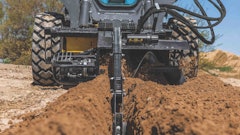
Few things in day-to-day construction operations are as important as safety. In fact, most would argue safety is hands-down the No. 1 priority. Every piece of equipment comes with safe operation practices all its own. As one of the most popular pieces of construction equipment, backhoe-loaders are present on nearly every jobsite so it’s especially important for backhoe operators to have solid training and awareness in safe operation.
Before a backhoe starts up for the day, throughout the workday, all the way until the operator goes home, backhoe safety must be top-of-mind. A safety strategy should be laid out and properly executed each day.
Rise and Shine
Start off the day on the right foot with some safety tips that begin before the backhoe goes to work.
Every backhoe operator should have thorough knowledge of the worksite. Two areas of particular concern with backhoes are utilities, both underground and overhead. An operator should never dig if he or she is unaware of what lies beneath the surface so the standard “call-before-you-dig” and utility markings should be taken care of before a project begins. During daily operation, it’s best to keep the backhoe away from areas with overhead power lines; however, if work is required near them, the operator must be aware and take caution not to make contact.
On a regular basis, before work starts for the day, everyone onsite should review the basic hand signals common with backhoe operation. This ensures clear communication and understanding between the machine operator and workers on-foot.
Prior to starting the machine, conduct a quick walk-around and inspection, looking for any visible signs of damage, excessive build-up of debris, broken mirrors or lights, or anything else that could be a safety hazard. Any items of concern should be addressed immediately to prevent potential safety incidents during the workday.
After the backhoe has been cleared to begin work, maintain three points of contact when entering the cab. Clean the operator station of any clutter that could get in the way and, as a final safety check, test the horn and backup alarm to be sure both are in proper working order.
Daily Operation
Most backhoes are set up to run on either a backhoe or excavator digging control pattern. Be sure to check the setting prior to doing any work in case someone else operated the machine and changed the setting.
If the backhoe is driving from one area or site to another, ensure the boom is locked and the swing lock is in place.
A few simple operation best practices can also go a long way to enhancing safety for the operator and others onsite. First, always use the stabilizers when digging. Don’t operate the backhoe on steep or uneven grades, or too close to a ledge, to prevent tipping or falls. It’s also advised to keep a load close to the ground, only raising it until it’s at a spot ready to be dumped.
Calling it a Day
After a long day on the jobsite, it’s tempting to shut down the backhoe and leave – however, a few final checks and practices are necessary to end the day on a safe notes.
First, be sure there are no workers near the machine who could be in harm’s way as the machine goes through its shut-down process.
Park the backhoe on a flat, stable surface and lower the boom to a safe position, ensuring the bucket is fully on the ground. Next, engage the parking brake – even though the machine is parked on a level surface, it’s a good final step to take and ensures the machine is in a fully-secured, safe position for the first person who uses it the next morning.
Exit the backhoe, again, maintaining three points of contact, then do a final walk-around. Check for any excess debris build-up, as well as areas that look to be damaged and could possibly be missed during the following morning’s safety checks.
Day In, Day Out
Above all else, safety of yourself and fellow workers should always be put first. When operating a backhoe, having a safety checklist is a great way to ensure the busyness and chaos of the workday doesn’t take away from sound safety practices. Start with these key areas then expand your daily program to meet the unique needs of your jobsite, workers, and equipment.




























